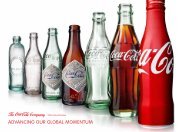Water Stewardship and Replenish Report - Psddev.com
Water Stewardship and Replenish Report - Psddev.com
Water Stewardship and Replenish Report - Psddev.com
Create successful ePaper yourself
Turn your PDF publications into a flip-book with our unique Google optimized e-Paper software.
Meeting Our Reduce Goal<br />
Greater efficiency in our water use does not mean making less product—we intend to reduce our water use ratio while growing our<br />
business. Globally, approximately 60% of the water used in our bottling plants is for processes such as rinsing, heating, <strong>and</strong> cooling. We<br />
have made these processes more efficient by:<br />
Using ionized air instead of water to rinse product packages<br />
Reusing treated process water for l<strong>and</strong>scape irrigation <strong>and</strong> truck washing<br />
Advancing our monitoring of water use <strong>and</strong> efficiency<br />
Meeting Our Recycle Goal<br />
The Coca-Cola Company believes that we have a responsibility for not only the quality of water that goes into our beverages, but also the<br />
quality of water that is discharged from our plants as a result of our manufacturing processes. To meet this responsibility, we established<br />
an internal wastewater treatment st<strong>and</strong>ard that applies to our entire global system. The number of Coca-Cola system facilities meeting our<br />
wastewater st<strong>and</strong>ard continues to move toward the goal of 100% <strong>com</strong>pliance <strong>and</strong> we continue to monitor <strong>and</strong> work closely with facilities<br />
to make sure they achieve <strong>com</strong>pliance. Most of the non-<strong>com</strong>pliant facilities have wastewater treatment plants under construction, with<br />
<strong>com</strong>pletion <strong>and</strong> start-up scheduled for 2012. Several of these operations are recent acquisitions, <strong>and</strong> plans have been formulated to achieve<br />
<strong>com</strong>pliance as they are integrated into the system. Delays in <strong>com</strong>pliance can be attributed to bureaucratic issues with construction <strong>and</strong><br />
installation permits, construction delays due to local conditions (such as weather <strong>and</strong> civil unrest), or financial <strong>com</strong>plications.<br />
Meeting Our <strong>Replenish</strong> Goal<br />
Through the end of 2011, we balanced an estimated 35% of the water used in our finished beverages (based on estimated 2011<br />
production volume) 8 by replenishing water with a focus on local needs <strong>and</strong> specific source vulnerabilities. We are achieving this balance<br />
through diverse, locally relevant CWP projects that support <strong>com</strong>munity needs for safe <strong>and</strong> sustainable sources of water, while protecting<br />
our ability to do business responsibly, safely, <strong>and</strong> more sustainably. We recognize, however, that we will have to continue adding new<br />
projects <strong>and</strong> maintaining the productivity of existing projects if we are to meet our 2020 goal. The Nature Conservancy, with support from<br />
LimnoTech, <strong>and</strong> the Global Environment & Technology Foundation have helped us calculate the volume replenished using an approach<br />
based on widely accepted tools <strong>and</strong> methodologies. For more about our project quantification, please visit thecoca-cola<strong>com</strong>pany.<strong>com</strong>/<br />
citizenship/<strong>com</strong>munity_initiatives.html.<br />
It is important to note here that we freely acknowledge that the science <strong>and</strong> methodology governing quantification of water benefits<br />
<strong>and</strong>/or achieving water neutrality are new <strong>and</strong> developing. We hope the assessment <strong>and</strong> methodology discussed in this report will<br />
contribute positively to the ongoing exploration of this emerging discipline. Our objective in reporting our efforts to calculate the water<br />
benefits associated with our “replenish” work is to show how we are doing. But, it also is for the purpose of continuing an open <strong>and</strong><br />
transparent dialogue on the appropriate science <strong>and</strong> methodology to be used to quantify water benefits <strong>and</strong> ultimately, water neutrality.<br />
We do not intend to say through this report that we have everything correct, although we believe that our estimation(s) of water benefits<br />
<strong>and</strong> the underlying methodology that we used are sound. We expressly acknowledge that it may be premature to rely on our water<br />
benefit calculations as hard fact.<br />
Managing <strong>Water</strong>-Related Risk<br />
Both <strong>com</strong>prehensive <strong>and</strong> local water risk assessments have been instrumental in helping us identify global water challenges, refine<br />
our corporate water strategy, <strong>and</strong> promote sustainable water resources management. Our source water protection program continues<br />
progressing toward its targets. By the end of 2011, approximately 70% of our facilities had <strong>com</strong>pleted the source water protection<br />
planning phase <strong>and</strong> more than 40%—320 plants—were in the implementation phase. We are on track for 100% of plants to be in the<br />
implementation phase by the end of 2012.<br />
< pg 28 pg 29 >




